by tmoffett | May 29, 2012 | Color, Landscape, Photographic Technique
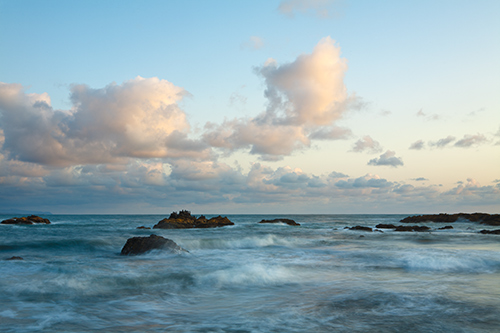
View from Cobble Beach, Newport, Oregon
I don’t know why, but I am really drawn to the water. Any water. Rivers. Streams. Lakes. But mostly the ocean. I am in the middle of giving final exams in my classes and I am really wishing I was at the beach with my camera instead. It doesn’t help matters that everywhere I turn I have photographs reminding me of how much I enjoy the coast.
One reason, I think, that I enjoy photographing moving water so much is the variety that it offers. You can stop the waves and capture every droplet of water as it sprays toward the shore, you can slow things down and capture the flow of the water over the rocks, or you can go anywhere in between. What I am feeling at the time usually dictates how I see the water and how I will photograph it. I often teach, especially in my beginner courses, to experiment with different exposure settings to see what happens to the image. I rarely do much experimenting when out photographing. I see what I see, my vision, and that is what I photograph. In earlier days I did the experimenting. I learned what happens when I use a long shutter speed. I learned how fast I needed to shoot to stop the water in a fast-flowing river. Now I spend more time experiencing the scene and then photographing it the way I feel it to be. The techniques have become my tools. I use these tools to create images resembling my vision. The tools enhance my creativity.
This particular evening at Cobble Beach, I met the Park Ranger as I was descending the steps to the beach. I was informed that I must be off the beach 10 minutes before sunset and out of the park 10 minutes after sunset. This threw a damper in my plans, as I love photographing long after the sun goes down. I felt rushed to get what I wanted, and upon reviewing my photographs from that evening, I think it affected me. Instead of creating soft, flowing images of a relatively smooth sea, I found myself using an “in between” shutter speed that would enhance the waves and make the scene appear more turbulent than maybe it really was. All of my exposures showed that look and feel. It was definitely different than what I shot the rest of that trip. It was proof to me that my emotions do affect the way I see, and therefore the way I photograph. I like it that way!
by tmoffett | May 24, 2012 | Color, Composition, Ramblings
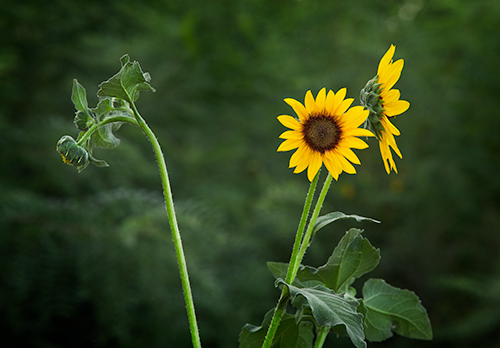
Sunflowers, Lake Lowell
I like a simple life. A walk on the beach. An afternoon nap. Daydreaming. A bike ride. A good book and an hour to kill. When I can slow down and enjoy life, my vision becomes clearer. I see things that otherwise I may pass by.
It is too easy to let life get complicated, and then we miss so much. When rushing from point A to point B it is difficult to focus on the journey, yet the journey is what should be important. I have to remind myself often of that fact. This simple image of a couple of sunflowers is a reminder to me to simplify. As I was on a walk out at the lake one evening, I passed by a patch of sunflowers, and these two blossoms caught my attention. I had to work to find an angle that would isolate them and simplify the composition while maintaining the feeling that they instilled in me. Much like in life, simplifying takes effort. We must work at it and strive for it. When we succeed, it is a beautiful thing.
by tmoffett | May 22, 2012 | Color, Landscape, Photographic Philosophy, Photographic Technique
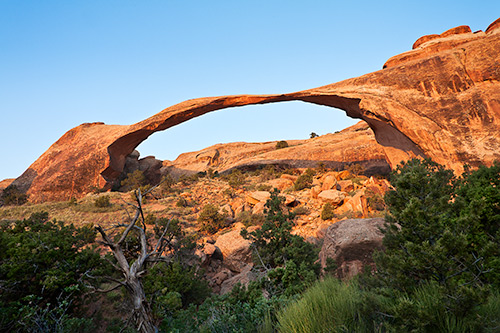
Landscape Arch, Arches National Park
My life can get quite crazy when on a photography trip. I arise early, oftentimes 4:00 A.M. or earlier and head out to a predetermined location. Frequently a pre-dawn hike is required and I arrive in plenty of time to prepare for sunrise. I never like to be rushed. Photography for me is not a job, it is an experience, and one to be enjoyed! Once I arrive at a location, I try never to hurry, I observe, I meditate, I let all of my senses go to work so that I can fully experience where I am. Only after I find myself can I really create an image that will have any impact at all. Once I have determined what it is that I will photograph and how I will photograph it, I set up and wait. As the sun nears the horizon, the light quality gets better and better, then all at once it becomes great! I shoot away, making subtle adjustments between exposures until everything is just right, then nearly as quickly as it came, the light is gone. Sometimes in the morning, the real good light only lasts a few short minutes, then it becomes harsh and uncontrollable. All of this effort for sometimes a mere five minutes of great light. Worth it? Absolutely! So much so that I turn around and do the same thing in the evening.
Evening photography is a little different than sunrise photography. The light quality stays good for me longer in the evening than in the morning, mostly because I love the light after the sun sets. I often, during the summer months, will shoot until after 10:00. This makes for some really short nights, but very much worth it in my opinion. I do need a few days to recover after returning home from a photography “vacation.” Why do I do it? It is who I am. I love photography, and great photographs are made at the ends of the day. I once heard a friend respond to someone questioning why it was necessary to get up so early. His response was that “At five o’clock you’re a photographer but at 11:00 you’re just another tourist.” How true that is. Avoiding tourists and enjoying the sights in a kind of light that you will never find at mid-day is part of what drives this passion of mine.
by tmoffett | May 17, 2012 | Color, Composition, Photographic Philosophy
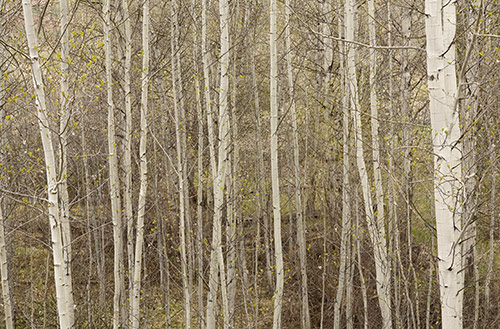
Aspens, Sun Valley, Idaho
Part of my job as a photographer is to simplify the chaotic world that we live in so that the images created in my camera are easy and interesting to look at. Most of the time, the scenes that present themselves to us are filled with so much “stuff” that it is hard to isolate individual elements. If we don’t train ourselves to look for simplicity, we will rarely find it. I often tell my students that I see the world better than they do because I see differently. I have looked so long for small elements that interest me that that is now what I see. My photographs are my vision. That is how I see the everyday world.
Composition is critical to creating interesting images. Painters, I think, have the advantage here because they start with a blank canvas and add only those elements that are needed for the image. Photographers, on the other hand, must find those compositions in nature, and then capture them in the camera. One afternoon as I was walking along the river in Sun Valley, I happened upon this aspen grove. When you look into the photograph, there is a lot going on, however as I looked and thought about what it was that made me stop, I realized that the repeated vertical lines of the tree trunks are what interested me. The muted color and tones created by a late afternoon overcast sky enhanced a feeling of peace and calm. Given the time, I could sit in the middle of this grove in meditation for hours and not feel bored. The strong vertical lines of the trees give my eyes a pattern to follow and places to rest after wandering throughout the other areas of the photograph.
I love finding images that seem to create order out of chaos. My vision is a very simple vision, and in the fast paced society in which we live, visualizing the simple things slow life down for me and helps me to live a more relaxed life.
by tmoffett | May 15, 2012 | Color, Composition, Landscape, Photographic Philosophy
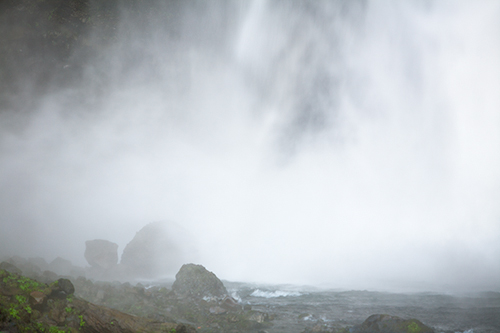
Impact Zone, Multnomah Falls
When traveling to the Northern Oregon Coast I will frequently stop at Multnomah Falls, a very popular and spectacular waterfall that is right next to the highway. I find it interesting that even though I have stopped and photographed this waterfall on numerous occasions, I have never printed an image of the entire falls. I am, for some reason, drawn to the details of this amazing display of water power. This past trip through the Columbia River Gorge was no different. I hiked up to the bridge that provides a great view of impact zone, the area where the falling water meets the pool below. It was fascinating to me. I stood watching as the spray of cold water soaked me and my gear to the bone. I realized what it was I needed to photograph. The trouble was figuring out how to keep my lens dry enough to get the image.
I set up my camera on the tripod and, not worrying at first about getting wet, framed up the image. I needed to capture the falling water at the edge of the frame with the spray and mist blowing through the frame to the left side, causing a thick haze across the entire frame. After framing it up and calculating the needed exposure to show the texture of the falling water in the background and create the desired haze in the foreground, I dried the lens and, with the help of my wife, kept the lens covered until just prior to tripping the shutter, then immediately after the exposure, covered the lens again. About every third shot, I stopped to dry off the lens again. It was quite a challenging process, however very rewarding as well.
Masterpieces are very rarely created in an easy setting. I believe that it is the challenges that allow us to create great images. In photography, just as it is in life, anything worth doing is worth working for. In conditions where everyone else packs it in and goes home, he who perseveres is bound to create something great. It is that challenge that I am constantly striving for. That is one reason that when I saw the forecast for heavy rain I opted to go to the coast. I knew that the adverse conditions would force me to look at things a little differently than I had in the past. I would attack the situation head on and was confident that I could win. I certainly was glad that I did as I returned home with a few great images added to my portfolio.







Recent Comments